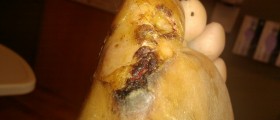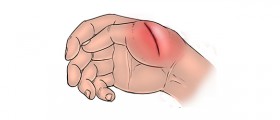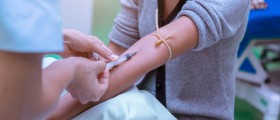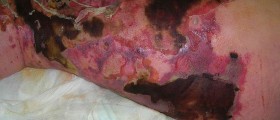Cellulitis is an inflammation of connective tissue of the skin. It is a common skin disease that can have serious consequences. The skin infected with cellulitis looks swollen, red, and is sensitive to touch, and the infection spreads quickly. Parts of the skin that usually get this infection are the lower legs, but other parts of the body can get infected as well.
One kind of cellulitis changes only the surface of the skin, and the other changes deeper layers and can even spread to the lymph nodes and get into the blood. It is very important to treat cellulitis on time because it is a fast-spreading disease and can even cause death as a consequence.

Symptoms
Most common symptoms of cellulitis are redness of the skin, swelling, pain, irritation, warmth of the place infected, tenderness, and even high body temperature or fever. Infected areas spread rapidly, and redness can sometimes be accompanied by small blisters. It is very important to consult the doctor in case a person notices any of the mentioned symptoms because the infection spreads fast through the body.
Causes
One of the things that causes cellulitis is bacterium which enters the body through a crack in the skin. The most common bacteria that cause cellulitis are streptococcus and staphylococcus. Typically, cellulitis occurs on the lower leg, so any cuts from surgery, puncture wounds, an ulcer, dermatitis, or athlete's foot may be passages for bacteria to enter the body. There is also a type of spider that transmits the bacteria that causes the infection.
Treatments and Prevention
If diagnosed in its early stages, cellulitis is treated with antibiotics. Although the therapy lasts for up to fourteen days, symptoms of cellulitis usually disappear a couple of days after starting the therapy. If the symptoms do not disappear, the doctor will probably have to prescribe another type of antibiotic or administer them intravenously. To prevent cellulitis from occurring, but also other infections, it is important to wash hands with soap and water, treat surface wounds with antibiotic creams, and react if any of the signs of infection appear.
People who suffer from diabetes should be extremely cautious about their skin wounds because their wounds sometimes take time to heal. Everybody should inspect their feet regularly and look for signs of injury.
If there are some, then the infection can be caught in its early stages. Everybody should take care of their skin, use moisturizing creams, trim fingernails, and toenails carefully, protect hands and feet, and wear appropriate shoes and gloves if necessary. Although conditions such as athlete's foot can look harmless, they are quickly spread from person to person and can cause more serious conditions.
- In 2014–5, cellulitis was listed as a primary diagnosis for 114,190 completed consultant episodes in secondary care and 75,838 inpatient admissions with a median length of stay of 3 days with a mean patient age of 63. Many more cases are treated in primary care.
- Gram-positive cocci such as Streptococcus spp and Staphylococcus aureus are thought to be the predominant cause of cellulitis. Positive blood cultures are found in less than 10% of cases. Wound or tissue cultures are negative in up to 70% cases, with S aureus, group A streptococci and group G streptococci being the most common isolates from wound cultures. Serological studies suggest group A streptococcal infection is an important cause of culture negative cellulitis. Skin infection with pus is strongly associated with S aureus.
- Making the correct diagnosis is key to management. Non-infectious conditions should be considered.
- Narrow spectrum penicillins targeting streptococci and staphylococci (in the case of purulent infection) should be the mainstay of antimicrobial therapy.
- The natural history of cellulitis is one of slow resolution. Fever and inflammation often persist during the first 72 hours of treatment. Management should include limb elevation and continuing narrow-spectrum antimicrobial therapy alongside treatment of comorbid conditions exacerbating the cellulitis (oedema, diabetes, vascular disease).
- Outpatient parenteral antimicrobial therapy (OPAT) (including ambulatory care) is often appropriate in patients requiring intravenous therapy, but presents challenges in terms of antimicrobial agents used. Daily review and early switch to oral therapies is optimal.
- In patients with recurrent episodes of cellulitis, risk factors should be addressed and consideration given to prophylaxis.

















Your thoughts on this
Loading...